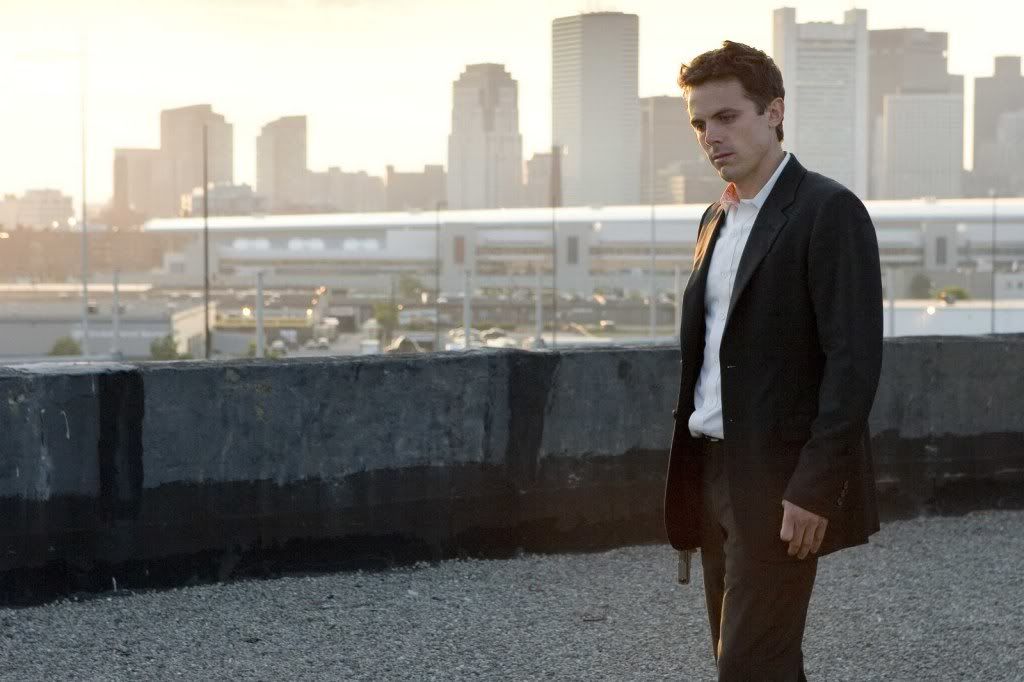
If you are to believe the entertainment machine, Boston is the worst city in the United States (a dear friend of mine who's been transplanted to Boston for the past few years assures me that yes, it is in fact the worst city in the United States, for a variety of reasons I won't go into here). Just think about the last few Boston-set entertainments you may have encountered: The Town (Boston is characterized by poverty and gang violence), Infinite Jest (Boston is characterized by drug addicts and Canadian wheelchair terrorists), The Departed (...poverty and mob violence), Mystic River (...rape, poverty and murder), Rescue Me (...rape, crime, poverty, murder and Dennis Leary), On Beauty (...racism and terrorism), Fringe (...space-time vortices and wormholes).
Gone Baby Gone wastes no time in introducing the horribleness: the camera pans around showing emaciated prostitutes and a whole lot of people weeping in various white trash locales. This first scene is a real shame considering how good the rest of the film is; it sets the film up to be melodramatic feel-baddery rather than the taut and suspenseful crime thriller it becomes.
The main plot-line kicks off as Helene McCready (a nearly unrecognizable Amy Ryan) awkwardly begs for everyone to help her find her missing daughter (the awkwardness may be explained by the fact that Helene's natural, off-camera speech tends to be 8/10 profanity, 1/10 article and 1/10 pronoun). Patrick Kenzie and Angie Gennarro, private investigators who also happen to be lovers, are called in to "augment" the police investigation by Helene's distraught sister, Bea, and Bea's husband. The police aren't too keen about Patrick and Angie's "help," but give them latitude since Patrick's a local boy who can get the neighborhood kids talking.
Casey Affleck plays Patrick perfectly; he's quiet and self-effacing but immeasurably tough. He plays his emotions so close to the chest that everyone in this film wants to tell him not what he should feel guilty about, but what he will feel guilty about. The bad men in this film, in their supreme arrogance, are convinced that not only is corruption the game they must play, but that it is the only right thing to do. They do not believe that anyone on this earth might actually have principles worth defending. Both Patrick and Angie are living counterpoints to this sort of moral flexibility, albeit in very different ways.
Once the story gets going, it doesn't stop for anyone. It snakes around from one life-threatening moment to the next, each one more tense than the previous. Patrick charms his way through mainly with words, and by the time he pulls a gun, things get very serious indeed. As the case takes its toll on both Patrick and Angie, his decisions become more erratic, more unpredictable, and when he stumbles upon the answer to the mystery its as much an accident as anything else, and we share his surprise at the truth.
Which brings me to the one mystery that's never quite cleared up: what's the story with our protagonists? Both of them seem to be unhealthily touched by the case, which hints at some past trauma or related sadness. In Patrick's case, at least, its suggested that his concerns stem from a stern Catholic upbringing, but in Angie's case, it's never quite made clear. To say she takes the case personally is a massive understatement. She is a strong character who breaks like a desiccated leaf when she accepts that the little girl is dead. Patrick, of course, doesn't accept that the girl is dead, and becomes a crusader in reuniting the girl with her deadbeat mother. Not only that, he commits himself to making sure that his decision to reunite them becomes the right decision, taking it upon himself to become a sort of guardian to the child.
The film would be captivating enough on its own, but its true strength comes from its superb cast. I mentioned Casey Affleck, riveting in his youthful interpretation of a soft-boiled detective. Amy Ryan humanizes a performance that could descend so easily into caricature. I kept comparing her performance mentally with the "bigness" of Melissa Leo in The Fighter, who played her character as the Norma Desmond of working class Boston (hey, another white-trash Boston movie!). And then there's the supporting cast: tight-lipped brass played by Morgan Freeman and Ed Harris (seriously, get that man an Oscar!), two of the best actors in Hollywood today. Oh, and of course, a shout-out to Ben Affleck's tight and effective directing of the film.
If there's one problem with the film, I'd say its the casting of Titus Welliver as Helene's brother-in-law. While it's not entirely his fault, I find it impossible to see him as anything other than a snake-in-the-grass villain.
Go watch it! Then come back and tell me what you think. What the hell's going on with Angie? Does anyone else think that Casey Affleck looks like a less plastic John Barrowman?


What did you think about the whole issue as to whether the Case Affleck character made the right decision in the end?
ReplyDeleteI think he made the right decision, morally, ethically and legally. I like the note of ambiguity about Helene potentially continuing on exactly the same as before, but at the end of the day, the little girl is her daughter.
ReplyDeleteIt's not even a choice between equivalencies; the men who kidnapped her didn't just kidnap her, they got a lot of people killed. Helene may not be the greatest parent, but she's not a murderer (yet).
This is why Angie comes off a little loony to me at the end; we're not really given background as to why she's quite so dogmatic that Patrick leave the child where she is.